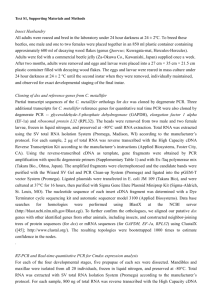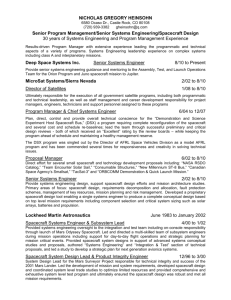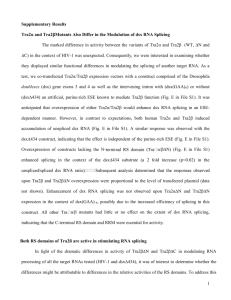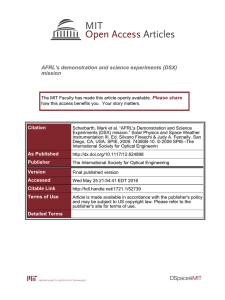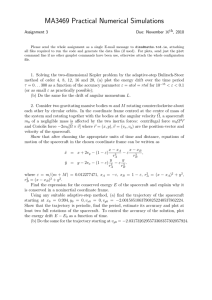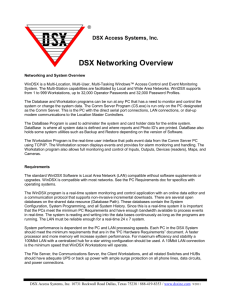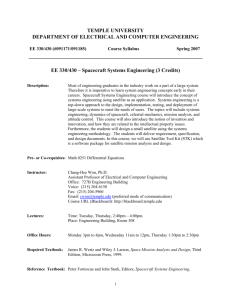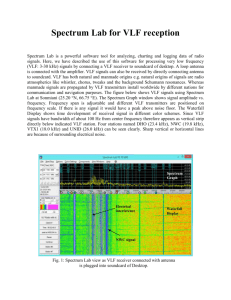THE DEMONSTRATION AND SCIENCE EXPERIMENTS (DSX):
advertisement
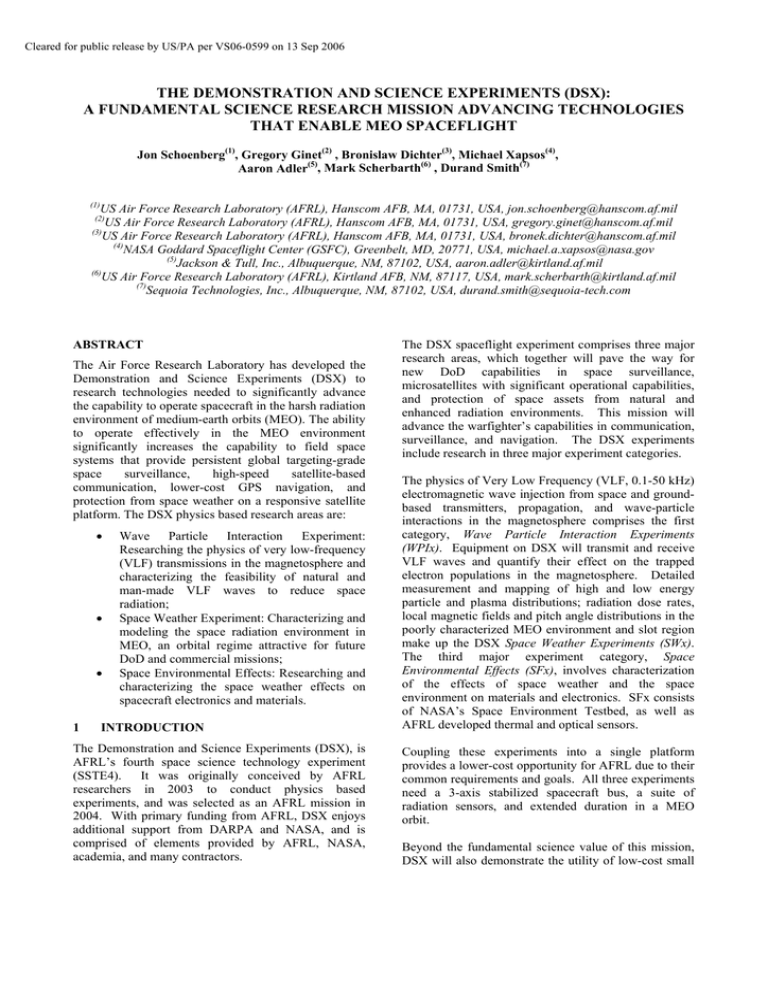
Cleared for public release by US/PA per VS06-0599 on 13 Sep 2006 THE DEMONSTRATION AND SCIENCE EXPERIMENTS (DSX): A FUNDAMENTAL SCIENCE RESEARCH MISSION ADVANCING TECHNOLOGIES THAT ENABLE MEO SPACEFLIGHT Jon Schoenberg(1), Gregory Ginet(2) , Bronislaw Dichter(3), Michael Xapsos(4), Aaron Adler(5), Mark Scherbarth(6) , Durand Smith(7) (1) US Air Force Research Laboratory (AFRL), Hanscom AFB, MA, 01731, USA, jon.schoenberg@hanscom.af.mil US Air Force Research Laboratory (AFRL), Hanscom AFB, MA, 01731, USA, gregory.ginet@hanscom.af.mil (3) US Air Force Research Laboratory (AFRL), Hanscom AFB, MA, 01731, USA, bronek.dichter@hanscom.af.mil (4) NASA Goddard Spaceflight Center (GSFC), Greenbelt, MD, 20771, USA, michael.a.xapsos@nasa.gov (5) Jackson & Tull, Inc., Albuquerque, NM, 87102, USA, aaron.adler@kirtland.af.mil (6) US Air Force Research Laboratory (AFRL), Kirtland AFB, NM, 87117, USA, mark.scherbarth@kirtland.af.mil (7) Sequoia Technologies, Inc., Albuquerque, NM, 87102, USA, durand.smith@sequoia-tech.com (2) ABSTRACT The Air Force Research Laboratory has developed the Demonstration and Science Experiments (DSX) to research technologies needed to significantly advance the capability to operate spacecraft in the harsh radiation environment of medium-earth orbits (MEO). The ability to operate effectively in the MEO environment significantly increases the capability to field space systems that provide persistent global targeting-grade space surveillance, high-speed satellite-based communication, lower-cost GPS navigation, and protection from space weather on a responsive satellite platform. The DSX physics based research areas are: • • • 1 Wave Particle Interaction Experiment: Researching the physics of very low-frequency (VLF) transmissions in the magnetosphere and characterizing the feasibility of natural and man-made VLF waves to reduce space radiation; Space Weather Experiment: Characterizing and modeling the space radiation environment in MEO, an orbital regime attractive for future DoD and commercial missions; Space Environmental Effects: Researching and characterizing the space weather effects on spacecraft electronics and materials. INTRODUCTION The Demonstration and Science Experiments (DSX), is AFRL’s fourth space science technology experiment (SSTE4). It was originally conceived by AFRL researchers in 2003 to conduct physics based experiments, and was selected as an AFRL mission in 2004. With primary funding from AFRL, DSX enjoys additional support from DARPA and NASA, and is comprised of elements provided by AFRL, NASA, academia, and many contractors. The DSX spaceflight experiment comprises three major research areas, which together will pave the way for new DoD capabilities in space surveillance, microsatellites with significant operational capabilities, and protection of space assets from natural and enhanced radiation environments. This mission will advance the warfighter’s capabilities in communication, surveillance, and navigation. The DSX experiments include research in three major experiment categories. The physics of Very Low Frequency (VLF, 0.1-50 kHz) electromagnetic wave injection from space and groundbased transmitters, propagation, and wave-particle interactions in the magnetosphere comprises the first category, Wave Particle Interaction Experiments (WPIx). Equipment on DSX will transmit and receive VLF waves and quantify their effect on the trapped electron populations in the magnetosphere. Detailed measurement and mapping of high and low energy particle and plasma distributions; radiation dose rates, local magnetic fields and pitch angle distributions in the poorly characterized MEO environment and slot region make up the DSX Space Weather Experiments (SWx). The third major experiment category, Space Environmental Effects (SFx), involves characterization of the effects of space weather and the space environment on materials and electronics. SFx consists of NASA’s Space Environment Testbed, as well as AFRL developed thermal and optical sensors. Coupling these experiments into a single platform provides a lower-cost opportunity for AFRL due to their common requirements and goals. All three experiments need a 3-axis stabilized spacecraft bus, a suite of radiation sensors, and extended duration in a MEO orbit. Beyond the fundamental science value of this mission, DSX will also demonstrate the utility of low-cost small satellite platforms to accomplish major science objectives. DSX uses a modular design that allows for launch either as a dedicated satellite on a small launcher, or as a dual-manifest on a larger rocket. Another key feature is the use of a dedicated payload computer, which unburdens the avionics of the need to conform to custom payload data interfaces, enabling the rapid procurement of a standard spacecraft bus. An overview of the DSX science, spacecraft design, flight operations, and engineering approach will be described. 2 FLIGHT EXPERIMENT CONCEPT The functional baseline configuration for the DSX flight experiment is shown in Fig. 1. The core is the Evolved Expendable Launch Vehicle (EELV) Secondary Payload Adapter (ESPA) Ring [1, 2], which is used to maximize launch opportunities on both Space Test Program (STP) and operational DoD launchers. ESPA was developed and designed by CSA Engineering. Every EELV launch is a potential ride for an ESPA ring, and thus also for DSX. The ESPA ring comprises the primary structure for DSX, and is upgraded to provide host spacecraft functions (avionics, TT&C, ADCS, C&DH, and power management and distribution) by the addition of components packaged on an avionics module (AM). The DSX payloads (including deployable booms) are mounted on an identical structure, the payload module (PM), attached to the ESPA ring opposite the avionics module. The AM and PM together comprise the DSX Host Spacecraft Bus (HSB). The entire assembly is designed to be stowed within a 4-m diameter EELV fairing. The design intent for the ESPA was for it to remain attached to the launch vehicle upper stage to facilitate deployment of up to six microsatellites. However, unlike the traditional ESPA approach, the DSX AM and Z Axis Booms •VLF Electric Field Rx •DC Magnetometer PM do not separate; they remain attached. After the primary satellite is deployed, the DSX ESPA separates from the EELV 2nd stage booster to become a free-flyer spacecraft. The ESPA ring serves as the DSX spacecraft’s primary structure, with an upper separation interface to the primary payload adapter and a lower separation interface to the EELV upper stage adapter. Fig. 2 shows DSX and identifies its major components in a stowed configuration. The experiment is baselined for flight in the radiation belts with a nominal orbit of 6,000 km x 12,000 km elliptical, mid-inclination, and 1year of mission operations. FORWARD SEPARATION I/F EELV UPPER STAGE SEP I/F Payload Module (PM) X Avionics Module (AM) Y Z Residual Separation Hardware ESPA Figure 2. DSX baseline stowed configuration. From the earliest DSX conceptual planning, it was understood that the key to a successful program execution was maximizing DSX’s compatibility with numerous launch vehicles. While the ESPA-based approach makes every EELV a potential ride, not all comanifest opportunities possess sufficient excess launch vehicle performance needed to inject DSX into its uncommon MEO orbit. Therefore, flexibility in the design will be maintained for as long as possible to allow repackaging DSX for flight on dedicated launchers. Inherent in the modular approach shown in 25-m 8-m Avionics Module (AM) •Attitude Control System •Power •Thermal Control •Communications •Bus Computer •Experiment Computer •Space Weather (1) Payload Module (PM) •VLF Broad Band Receiver •VLF Narrow Band Receiver •VLF Transmitter/Amplifier Tuners •Loss Cone Imager •Space Weather Instruments (4) •Space Environment Testbed •Radiometers •Photometers ESPA Ring •Primary Structure •Interfaces between EELV and Primary Satellite 25-m Y Axis Booms •VLF Electric Field Rx/Tx 8-m Figure 1. DSX baseline deployed configuration. X Y Tri-axial Search Coil (TASC) •VLF Magnetic Field Rx Z Booms not drawn to scale Fig. 2 is the ability to separate the two modules from the ESPA ring, and directly stack them in a vertical assembly for a dedicated launcher. The stacked HSB configuration is shown in Fig. 3, and fairing encapsulated views of DSX are shown for EELV, Minotaur IV/V, and Falcon 9 in Fig. 4. Space Segment DSX Mission Operations at RSC & VSES MOC Space –Ground Interface Remote Experiment Sites VAFB (SLC-3E) TCP/IP Comm to tracking network • Ground control Software • Telemetry Processing • Mission Analysis • Command Generation Global Tracking Network (AFSCN) All data gets compiled & stored at MOC/DC prior to dissemination to scientists Figure 5. DSX ground segment. Primary Payload Payload Forward (placeholder) (placeholder) Figure 3. DSX stacked configuration for dedicated launchers. Figure 4. DSX encapsulated (left Atlas V EELV, Minotaur V, and Falcon 9 to right): This modular architecture not only makes DSX reconfigurable for various launch vehicles, but it also greatly simplifies payload integration. (RDT&E) Support Complex (RSC) at Kirtland Air Force Base, New Mexico. All of the mission unique software and equipment and data archival and management required to support the mission will be located at the MOC/DC. From the MOC, the flight operations team interfaces with the users, payload and spacecraft equipment manufacturers, remote experiment support sites (optical and radar imaging ranges and VLF ground installations), and RSC operations personnel required to operate the mission. The RSC provides connectivity to the Air Force Satellite Control Network (AFSCN), and provides the necessary program action plans and satellite acquisition tables to schedule contacts with the DSX spacecraft. Commands will initially be developed from the MOC/DC where the effects will be simulated to validate proper operation. These commands will be sent to the RSC for uplink via Space-Ground Link System (SGLS) communication protocol to the DSX satellite. Downlinked information from the space vehicle stateof-health will be validated from the real-time operations system located at the RSC. All space-ground links will be accommodated by AFSCN. In addition throughout the spacecraft development and launch activity the RSC Satellite Operations Center will provide compatibility testing with the space vehicle at the factory and the launch site. The DC will collect all DSX data products, conduct analyses, archive data products, and distribute data products to Principal Investigators and users at AFRL and the NASA Payload Operations Control Center (POCC). The RF emissions flow for DSX is shown in Fig. 6. VLF Transmit Antennas 2.1 Ground Segment VLF-Band - Transmit 1 kHz to 50 kHz up to 1- kW and 50 kHz to 750 kHz << 1kW Space-to-Space (non-communication radiator) SGLS Uplink (Command & Ranging) The DSX ground segment consists of three major elements: mission control, global telemetry tracking and control (TT&C) network, and the remote experiment sites, as shown conceptually in Fig. 5. The DSX spacecraft will be operated from a combined Mission Operations Center/Data Center (MOC/DC) where the flight operations team performs the operations for all aspects of the mission. The MOC/DC will be colocated with the SMC Space Development and Test Wing’s Research, Development, Test and Evaluation 1760-1840 MHz (L-Band) 2kbps, FSK, Convolutional Encoding Omni Antennas SGLS Downlink (Telemetry/Mission Data) 2200-2300 MHz (S-Band) 1.024 Mbps, BPSK, Convolutional Encoding Omni Antennas MOC/DOC Commands AFSCN AFSCN ARTS ARTS Telemetry & Data SD&TW/RSC SD&TW/RSC Instructions DSX DSX PO PO Telemetry & Data DSX DSXData Data Distribution DistributionCenter Center Figure 6. DSX RF emissions flow diagram. DSX DSX PI’s PI’s In addition to SGLS communications bands, the spectrum allocation also includes VLF frequencies used for the wave particle interaction experiment. Preliminary orbit analysis performed for DSX has shown that AFSCN provides fairly continuous coverage over the orbit. The recommended minimum planning results in five passes per day of approximately 85 minutes each, of which 73 minutes are available for downlinking data at 2MBit/s. Fig 7 shows the DSX orbit, along with the AFSCN, optical, and radar ground stations along its track. AFSCN sites are labeled in blue, while optical and radar imaging sites are identified in purple. Figure 7. DSX ground stations. 3 3.1 DSX SCIENCE EXPERIMENTS Wave-Particle Interaction Experiment The Earth's radiation belts exhibit considerable dynamic behavior ranging from the creation and destruction of whole new belts in the slot region and outer zone (> 6,000 km) occurring on time scales of minutes-days to the slower diffusion of the innermost regions (< 6,000 km) occurring on timescales of months to years. A major cause of the energetic electron belt dynamics are wave-particle interactions driven by electromagnetic waves in the VLF range and below. These interactions will increase the electron velocity parallel to the local magnetic field by altering the "pitch-angle" (i.e. the angle between the particle's parallel and perpendicular velocity) and consequently lower the altitude at which the electron magnetically reflects along the field line, an effect due to the conservation of magnetic moment (Fig. 8). If the magnetic reflection is lowered to altitudes within the upper atmosphere, collisions with the plentiful neutral particles will lead to a depopulation of the radiation belt along that magnetic flux tube. Natural sources of VLF in the magnetosphere include natural “chorus” and “hiss” waves generated by space weather processes and lightning-induced whistler waves propagating along magnetic field-aligned ducts. To Figure 8. VLF wave particle interaction process. match current models of radiation belt dynamics to the observed behavior of electrons, it is necessary to postulate that man-made VLF leaking into the magnetosphere from ground-based submarine communications systems is also a significant source [3]. Direct measurements of VLF power have been sparse because scientific satellites with the required capability (e.g. the USAF CRRES [4] and NASA IMAGE [5] missions) have been in highly elliptic orbits with apogee > 6 Earth radii and consequently spend most of their time outside the inner belt and slot region. Placing a VLF receiver on the DSX satellite will allow for a quantitative determination of the current levels of natural and man-made VLF waves in the inner magnetosphere. Models of ground-based VLF injection and global magnetospheric propagation will also be validated in a controlled manner. The VLF transmitter on DSX will provide the capability to conduct active experiments to quantify space-based VLF waveinjection efficiency and determine the details of the wave-particle interactions. An electron loss cone detector on DSX will allow direct correlation of changes in energetic particle distributions with injected wave power. Accurate models of the VLF injection, propagation, and wave particle interaction processes will be developed and validated with DSX data. Such models are critical components of global radiation belt nowcast and forecast models required for space situational awareness and mission planning. The WPIx payloads consist of four major components, which are further described below. 3.1.1 DC Vector Magnetometer (VMAG) A DC fluxgate vector magnetometer (VMAG) will be used to determine the direction of the magnetic field to better than one degree at all points in the orbit. This performance will allow the mapping of locally measured particle distributions to global distributions. VMAG sensors will measure the DC B-field over a 10010000 nT range with ±0.1 nT accuracy at 20 Hz. VMAG data is also used in real-time by the LCI, as discussed in 3.1.4. VMAG will operate continuously to provide DC magnetic field and ULF wave environment data required by the SWx MEO space particle modeling experiment, thus it supports both WPIx and SWx experiment objectives. The VMAG electronics will be mounted within the payload module and the fluxgate sensor will be deployed on the tip of the –Z boom. VMAG is under development by UCLA, and is similar to other fluxgate magnetometers (shown in Fig. 9) by UCLA and flown on several missions (ST-5, Polar, FAST, and Galileo). Figure 9. VMAG fluxgate sensor package. 3.1.2 Wave-induced Precipitation of Electron Radiation (WIPER) broadband receiver (BBR) The WIPER broadband receiver (BBR) is a passive receiver designed to measure the natural and man-made ELF, VLF and LF signals in the inner magnetosphere in the range 0.1-50 kHz. The BBR (shown in Fig. 10) is electrically connected to all four deployed booms previously shown in Fig. 1, with two channels of the BBR measuring electric fields via the y and z-axis VLF antennas, and three more channels measuring magnetic field about each axis of the Triaxial Search Coil Antennas (TASC). TASC is mounted on the tip of the +Z boom and the BBR is contained within the payload module. BBR measurements are also coordinated with high power transmissions resulting from the WIPER transmitter, transmissions from ground based facilities, as well as naturally occurring sources of magnetospheric VLF (i.e., lightning, induced whistlers, chorus, triggered emissions, and hiss). The BBR is being developed by Stanford University and built by Lockheed Martin’s Advanced Technology Center. Figure 10. WIPER BBR (left) and TASC (right). 3.1.3 WIPER transmitter and narrowband receiver electronics (TNT) The WIPER transmitter electronics portion consists of the transmitter controller unit (TCU) with an integral narrow-band receiver (NBR) as well as two transmitter amplifier tuner units (TATU) shown in Fig. 11. Each TATU electrically connects to a pole of a center-fed dipole antenna supported by the ±Y booms shown in Fig. 1. The transmitter electronics include dynamic tuning circuits within the TATUs and controlled by the TCU. The VLF transmission system will broadcast up to the kilowatt level in the range 3-50 kHz and at much Figure 11. WIPER TCU (left) and TATU (right). lower power levels over 50 kHz - 750 kHz by charging conductive antenna elements that run along the Y-axis booms to levels up to 10 kV. The TCU/NBR and both TATUs are housed within the payload module. The WIPER transmitter electronics are being developed by the University of Massachusetts-Lowell and being built collaboratively with Southwest Research Institute, benefiting from significant heritage resulting from a similar payload flown on NASA’s IMAGE satellite. 3.1.4 Loss Cone Imager (LCI) The Loss Cone Imager (LCI) is an electron loss-cone particle experiment that will provide a measurement of three dimensional energetic particle distributions with emphasis on the measurement of the fluxes of energetic electrons along the direction parallel and anti-parallel to the local geomagnetic field vector. The LCI consists of three sensor systems. There are two rotating sensor heads (RSH), with ±180° motorized articulation capability, and each projects a 180° field of view fan with each scan head position, so that together the full 4π unit sphere may be imaged. In addition to full rotation modes each of the RSH can use data from the DC Vector Magnetometer (VMAG) for its motor pointing control loop and be oriented independently. The VMAG data is included in the LCI data stream for later ground data correlation. The third sensor system is a separate Solid State Detector (SSD) telescope called the High Sensitivity Telescope (HST). It will obtain fluxes of energetic electrons along the geomagnetic field vector direction. This telescope is designed to have a geometric factor of 0.1 cm2 steradian with sufficient shielding to permit the detection of 100 particles/cm2-sec-steradian in the loss cone. The LCI is under development by Boston University, and also benefits from heritage obtained in the development and flight of similar instruments such as the Imaging Electron Spectrometer (IES) on the ESA-NASA Cluster mission and the NASA Polar mission. The LCI scanning heads and HST are shown in Fig. 12. Figure 12. LCI, HST (left) and RSH (right). 3.2 Space Weather Experiments (SWx) angle between the particle velocity and magnetic field). Local pitch-angle distributions can then be used to estimate global particle distributions by mapping techniques using the well-known equations of motion and magnetic field models tagged to the local measurements. The nominal space weather sensor suite capabilities are described in detail in the following subsections. With an orbit between 6,000-12,000 km, DSX will explore a large swath of the inner magnetosphere, in particular the outer region of the inner proton belt the “slot region”, and inner regions of the outer electron belt. This domain has remained largely unexplored due to the understandable tendency of military, commercial, and scientific satellite systems to be located outside the intense regions of radiation, most often at LEO or GEO. However, increasing demands for uninterrupted coverage of the Earth from space are driving planners to consider putting satellite constellations in orbits spending significant time in the inner magnetosphere. Current standard space particle models (e.g. AE-8 and AP-8) can be off by as much as 50 times or more in estimating the time taken to reach hazardous dose levels in the MEO regime. It is imperative that measurements be made of the plasma and energetic particles so that adequate climatological, situational awareness, and forecast models can be developed to enable the successful design and operations of systems in these new and desirable orbit regimes. Accurate environment determination is important for DSX so that quantitative correlation with the performance of the spacecraft and its payloads over the course of the mission may be performed. Compact Environment Anomaly Sensor (CEASE) Composed of two dosimeters, two particle telescopes and a Single Event Effect (SEE) detector, CEASE has the capability to monitor a broad range of space hazards from surface damage and charging (keV electrons) to SEEs resulting from >100 MeV cosmic rays and solar protons [6,7]. The angular field-of-view for CEASE is relatively large and will not allow for pitch angle resolved measurements. CEASE will be mounted on an exterior panel of the payload module. One change for DSX is that CEASE will capture and downlink the full dose spectra from each dosimeter, whereas prior versions only captured six reduced data points: two for low linear energy transfer (LET) data and four for high LET data. The CEASE instrument was developed by Amptek, Inc. and has already flown on several spacecraft. Deficiencies of current standard radiation belt models in the inner magnetosphere include the lack of (a) spectrally resolved, uncontaminated measurements of high energy protons (10-400 MeV) and electrons (1-30 MeV) and (b) accurate mid to low energy (< 1000 keV) measurements of the energetic particle and plasma environment. Not surprisingly, most of the space weather data to-date has been accumulated in the LEO and GEO regimes, as illustrated in Fig. 13 with data from dosimeters aboard the TSX5 and DSP satellites in LEO and GEO, respectively. 3.2.2 Low Energy Electrostatic Analyzer (LEESA) LEESA will measure energy fluxes and energy spectra for low energy electrons and protons (100 eV to 50 keV). These low energy particles are responsible for surface electric charging and damage to thin films such as thin-film photovoltaics, conventional solar cell cover glasses, and coatings. LEESA will be mounted on an exterior panel of the avionics module. It is under development for DSX by Amptek, Inc. and AFRL. CEASE and LEESA are shown in Fig. 14. 3.2.1 Figure 14. CEASE (left) and LEESA (right). Figure 13. Space weather data from TSX5 and DSP The Space Weather instruments onboard and the unique orbit of DSX will address these deficiencies. Included will be electron and proton detectors measuring both the spectral content and angle of arrival of both species over broad energy ranges. An on-board magnetometer (see VMAG, 3.1.1) will allow for the transformation of angle-of-arrival measurements into estimates of the flux distribution with respect to the local pitch-angle (i.e. the 3.2.3 High Energy Proton Spectrometer (HEPS) HEPS will measure protons with energies between 15 and 440 MeV and electrons with energies between 1.5 and 20 MeV. These high energy particles are responsible for microelectronics damage, displacement and total dose damage, SEEs, and deep dielectric charging. HEPS (Fig. 15) will be mounted on the AM battery enable bracket. It was developed for DSX by Amptek, Inc. and is currently being completed by Assurance Technology Corporation (ATC). 3.3 Figure 15. HEPS electronics (left) and sensor (right). 3.2.4 High Energy Imaging Particle Spectrometer (HIPS) HIPS will measure electrons with energies between 110 MeV and protons with energies between 30 and 300 MeV. These high energy particles are responsible for microelectronics damage, displacement and total dose damage, SEEs, and deep dielectric charging. HIPS will be mounted on an exterior panel of the payload module. It is under development for DSX by Physical Sciences, Inc. (PSI). 3.3.1 Space Environment Testbed (SET) The SET carrier, shown in Fig. 18, under development by NASA GSFC provides standard mechanical, electrical, and thermal interfaces for a collection of small flight investigations. The general areas of investigation of the instruments carried on SET fall in the following categories: 1. 2. 3. 4. 5. 3.2.5 Low Energy Imaging Particle Spectrometer LIPS is designed to measure the ring current particles that are important in the energy flow processes in the magnetosphere. This particle population plays an important role in spacecraft charging and surface damage due to sputtering. The instrument, also built by PSI, uses specially designed combinations of scintillator materials to detect electrons and protons with energies between 20 keV and 1 MeV. Eight 10 degree by 8 degree field-of-view windows will provide pitch angle resolution. LIPS will be mounted on an exterior panel of the payload module, and is also being developed by PSI. HIPS and LIPS are shown in Fig 16. Space Environmental Effects (SFx) Characterization of the space environment; Performance improvement for microelectronics used in space; Accommodation and/or mitigation of space environment effects for detectors and sensors Accommodation and/or mitigation of charging/discharging effects on spacecraft and spacecraft components; Definition of mechanisms for materials’ degradation and performance characterization of materials designed for shielding from ionizing radiation. Figure 18. SET-1 (re-plate shown is non-flight). The DSX SET mission, SET-1, was recently added to the spacecraft experiment suite. SET-1 consists of several specific investigations which are summarized below. Figure 16. HIPS (left) and LIPS (right) DSX may be flying the most comprehensive suite of space particle instruments ever flown in MEO, from the perspective of composite particle energy coverage as shown in Fig. 17. HIPS HEPS Protons LIPS CREDANCE. Cosmic Ray Environment Dosimetery and Charging Experiment (CREDANCE) measures the radiation environment (total dose and single-event), and the charging environment for normal background and during space weather events. CREDANCE specific measurements include: 1. 2. LEESA HIPS Electrons 3. LIPS HEPS LEESA 0.0001 0.01 1 100 Energy (MeV) Figure 17. Space weather energy coverage of DSX. 4. Proton flux > 40 MeV per unit solid angle. Charge deposition in large silicon diodes arranged in telescopes. Pulse height analysis is used to obtain ion LET spectra of heavy ions in the 100 MeV cm2/g to 25,000 MeV cm2/g range. Threshold voltage shift as a function of time to measure total ionizing dose (TID) in silicon at two different shielding depths. Charging current at three different shielding depths which provides energetic electron flux measurements at three energies. CREDANCE measurements overlap in part with the CEASE space weather instrument, and will provide for mutual validation through cross-correlation of both instruments. CREDANCE has been developed by QinetiQ/UK. DIME. Dosimetry Intercomparison and Miniaturization Experiment (DIME) will measure space radiation environments which are detrimental to space system reliability using novel dosimetry techniques. DIME occupies two 3U card slots on the SET-1 carrier, and is being developed by Clemson University. Specific DIME measurements include: 1. 2. 3. 4. 5. Radiation-Sensing Field-Effect Transistor (RADFET) - threshold voltage shift as a function of time; converted to total ionizing dose (TID). Erasable Programmable Read-only Memory (EPROM) - threshold voltage shift as a function of time; converted to TID. Also number of single event upsets (SEU) as a function of time to measure rates as a function of radiation level. Ultraviolet erasable Programmable Read-only Memory (UVPROM) – charge stored on floating gates is neutralized with radiation exposure. Resulting bit flips reflect micro-dose deposited in gates. Linear Energy Transfer (LET) Spectrometer pulse height spectra as function of time; converted to LET to measure ions including protons. As with CEASE, one spectrometer is optimized for high LET ions and the other for low LET ions. Optically Stimulated Luminescent (OSL) Films – visible emission spectrum as a function of time gives a sensitive measure of the ionizing dose. ELDRS. Focused on characterization of proton effects and Enhanced Low Dose Rate Sensitivity (ELDRS) in Bipolar Junction Transistors (BJT), ELDRS measures space radiation induced total ionizing dose and displacement damage on linear devices sensitive to enhanced space low dose rate effects. ELDRS will measure base and collector currents for 24 commercial off-the-shelf (COTS) BJTs as functions of the emitter and gate voltages and time. ELDRS is being developed by Arizona State University (ASU). PolyRAD. – This is an alternate board experiment to be used if difficulties are encountered with any of the preceding board experiments. It will evaluate the flight performance of a new material used for spot shielding with the goal of enabling use of advanced COTS microelectronics. Total ionizing dose due to threshold voltage shift of RADFETs will be measured for both top-side shielding and net-shape shielding representing device encapsulation. The board was jointly developed by Longhill Technologies, Inc. and ASU. 3.3.2 Photometers and Radiometers DSX will fly several photometers and radiometers developed by AFRL’s Propulsion Directorate, as shown in Fig. 19. Together these will directly measure changes in optical transmission, thermal absorption and emission due to the MEO radiation environment. Coupon level testing of specific developmental coatings intended for thin-film photovoltaics may also be performed using these sensors. Figure 19. Radiometers (left) and photometers (right). 3.4 Packaging of the DSX Payloads The design for both the avionics and payload modules, and mechanical arrangement and packaging of payloads within the payload module has been performed by MicroSat Systems, Inc (MSI). The resulting payload and avionics modules equipment layout are shown below in Figs. 20 and 21, respectively. HIPS Magnetometer Booms (Z-axis) LIPS VLF Transmitter Booms (Y-axis) VMAG SH SET-1 CCA LEESA TATU-B SET-1 CEM BBR LCI DPU / HST TASC TCU VMAG EU TATU-A CEASE LCI RSH (2) Figure 20. Equipment packaging on payload module. Torque Rods (3) COTS-2. COTS-2 measures particle induced single event effects on a single event effects mitigation platform in normal backgrounds and during solar storm events. COTS-2 will measure single-event effects on COTS FPGAs, classify the event by event type, and determine if mitigation of the effect occurred without watchdog intervention. COTS-2 is being co-developed by NASA and CNES. Reaction Wheels (3) Li-Ion 30 Ah Battery (2) Sun Sensor (3) HEPS Helix Antenna (6) Photometer / Dosimeter Payloads (4) Battery Enable Bracket Omni Patch Antenna (2) ECS HSB Avionics Figure 21. Equipment packaging on avionics module. 4 CONCEPT OF OPERATIONS There are six separate and distinct mission CONOPS phases: (1) the launch and separation, (2) bus initialization, (3) experiment boom deployment, (4) post-deploy comprehensive checkout, (5) on-orbit experiment operations, and (6) end-of-life (EOL). The potential for residual operations before EOL would be defined as a seventh phase. For launch, the DSX system will be at minimum power operating from batteries and awaiting the signal indicating separation from the upper stage. Upon separation, a series of scripted commands will initialize the bus. After acquisition of a signal from the ground, and verification of nominal operation, the bus solar arrays deploy and the attitude control system is activated in a sun-safe mode in order to orient the spacecraft into a power-positive attitude. Ground controllers will make the first contact and perform health checks. Some instruments requiring early initialization will be turned on (i.e., VMAG) and the booms will be deployed in pairs to minimize the impact to the center of gravity and center of pressure of the spacecraft. Checkouts will continue after deployment followed by commissioning of each payload. Normal operations will be constrained by spacecraft power, data bandwidth and scheduling contacts through the Air Force Satellite Control Network (AFSCN). Therefore payloads will have to be duty cycled. SWx payloads are low impact on resources, basically single modes of operation, and can be turned on early for the duration of the mission with little intervention required. SFx and specifically the SET-1 instrument will have two operating modes that are dependent on solar activity (for S3 storms as detected by CREDANCE) and position in the orbit (triggered by orbit propagator indications of the ascending nodes). Resource demands for SFx are similar to SWx. WPIx is the most demanding on the DSX spacecraft resources, consuming the greatest power (>650 W peak) and generating the most data (up to 5 GB per orbit). High power VLF transmission is limited to ±20° latitude about the equatorial plane and to less than 30 minutes. The Adaptive Controls Experiment (ACE) is a secondary mission and, as its name implies, involves an adaptive controls experiment using the HSB attitude control system interacting with the deployed flexible structures. The only resource requirement for ACE is downlink of data generated from ACE. 4.1 Normal On-Orbit Operating Modes For normal operations the spacecraft will be in a magnetic field tracking mode with the VLF antenna (Yaxis) normal to the magnetic field; the Z-axis booms will be at 45° to the magnetic field. There are eleven other attitude control modes that are available for other mission phases, special operations and safe-hold mode. Tab. 1. summarizes the operating modes of all the science instruments. WIPER has eight normal operating modes that could be used during a typical orbit. In addition, in at least one mode, LCI will be operated in coordination with WIPER. SWx instruments have a single, powered on mode, with the exception of LEESA that has two operating modes, and are independent of WPIx and SFx. Similarly, SFx instruments have a single mode with the exception of SET-1 that has two modes, and are independent of WPIx and SWx. When the WIPER VLF transmitter is operating there may be interaction with SWx and SFx instruments and part of the data analysis will need to account for when the transmitter is on, as well as the possible effects on the natural environment. Table 1. Experiment modes description. Instrument WPIx WIPER No. of Modes Description 8 Quantify in-situ ELF/VLF wave injection & propagation (5) Quantify belt/slot region background ELF/VLF wave & plasma environment (3) Quantify loss cone particle spatial distribution, operation coordinated with WIPER Characterize magnetic field vector LCI 3 VMAG 1 SWx CEASE 1 LEESA 2 HIPS 1 LIPS 1 HEPS 1 SFx Radiometer 1 Photometer 1 SET-1 2 Quantify broad range of particles, cosmic rays, and single events Quantify flux and spectra for low energy electrons and protons Quantify electrons (1-10 MeV) and protons (30-300 MeV) Quantify electrons and protons (20 keV-1 MeV) Quantify el. (1.5-20 MeV) and pr (15-440 MeV) Quantify thermal changes (α and ε) Quantify changes in optical transmission Experiments that characterize space environment, microelectronics performance, detector performance, charging/discharging, shielding materials performance For purposes of characterizing the volume of data collected and orbital average power, a typical orbit-inthe-life has been constructed that illustrates the complexity of the WPIx experiment. All WIPER modes are operated and, in addition, a calibration and housekeeping mode are included. All other WPIx, SWx and SFx instruments are considered to be at their highest data rate and power modes. In addition to the payloads, the Host Spacecraft Bus (HSB) and the Experiment Computer System (ECS) are also accounted for. The HSB data and power are considered to be typical for stored state of health (17 MB), and HSB operating conditions (239 WOA). The ECS processes all payload data with the exception of the photometers and radiometers and also runs data compression algorithms for WIPER that reduces the WPIx from 1.9 GB to 260 MB. The total data from all sources for one orbit is 370 MB. This data volume requires a downlink time of 48 minutes at 1.042 Mbps with an Air Force Satellite Control Network (AFSCN) ground site. With the WIPER VLF transmitter operating for 30 minutes, at a 50% duty cycle at 650 W, the total payload orbital average power is 327 W. The budget for both the bus and payload is 350 WOA each, at end of life. 5 Technical Performance Measures Since its earliest stages of development, the DSX program has implemented a mass and power control process, and carefully tracks these metrics. A master equipment list has been developed to identify every equipment or structural element of the spacecraft, with mass and power consumption estimates, contingency estimates, and allocations. Summary forms of these budgets are presented in Tabs. 3 and 4, respectively. Note that the end-of-life (EOL) power generation reduction indicated in Tab. 4 is a . Table 2. Resource utilization by experiment mode. Mode ID HSB Magnetic Field Pointing Mode ECS WPIx WIPER 0 1A 1B 1C 2A Data after compression w/CCSDS headers, WAOP Calibration 16 Levels x 10 sec ea, 5-ch burst (H) 16 Levels x 10 sec ea, 5-ch burst (U) Broadband background, 50% duty cycle 30 min x 5-ch wave normal reduction Ground transmitter overflight, 1+ per orbit 30 min x 1-ch narrowband continuous 30 min x 2% duty cycle x 5-ch burst add’l High Power Transmitter Operation 30 min x 5-ch burst TNT/BBR focus experiments 15 min x 5-ch burst 2B TNT LCI focus experiments 15 min x 5-ch burst 2C TNT other spacecraft conjunctions 30 min x 5-ch burst Slot region/radiation belt passage, 2 per orbit 15 min x 10% duty-cycle x 5ch burst Continuous background survey Housekeeping (BBR + SRX) 6 Hz/100 Hz mode Powered On 3A LCI VMAG Operations Mode 3B Z 3 SWx HEPS CEASE LEESA LIPS HIPS Powered Powered Powered Powered Powered SFx SET-1 Radiometers Photometers HPNO Data included in HSB TLM Date included in HSB TLM Orbit Total Data (MB) 17 Power (W) 239 317 260 87 164 123 80 0 0 80 75 80 4 1 740 60 80 0 80 0 80 0 80 18 1 2 51 6 33 80 39 2 27 4 4 2 4 18 On On On On On 3 29 3 370 3 2 5 3 14 29 327 P/L 239 S/C result of photovoltaic degradation due to the severe MEO radiation environment. Table 3. Mass budget summary. Equipment Total Vehicle, Separated Mass Avionics Module (AM) Attitude Control (except IMU & Mag.) Avionics (C&DH and PMAD) Electrical Power S/S Thermal Control System (TCS) Telecom Experiment Computer SWx (HEPS) Harnesses AM Structure Payload Module (PM) WIPER, VMAG, LCI Y and Z booms SWx (CEASE, LIPS, HIPS, and LEESA) SET-1 Harnesses IMU, Magnetometer TCS PM Structure Primary Structure ESPA Separation Systems Harness Misc. Basic Mass (kg) 475 141 29 156 31 9 10 41 4 46 5 7 8 3 9 31 149 46 29 10 7 9 4 10 34 176 50 37 12 15 12 1 4 32 185 128 28 13 16 16 17 1 5 38 205 134 32 20 19 Maximum per ESPA port Maximum for fully populated ESPA 200 1206 Table 4. Power metrics and budget summary. Array Power Generation (W)* Battery Capacity* Bus Steady-State Avg. Power (SSAP, W)* SSAP Available for Payloads (W)* Composite WPIx Exp. SSAP (W) Composite SWx Exp. SSAP (W) Composite SFx Exp. SSAP (W) Total Payload Heater Power (W)* Table 5. Launch vehicle performance. Launch Option Mass w/Contingency (kg) 537 1320 BOL, 850 EOL 60 Amp-hr ~300 ~350 100 (normal), 750 (HP transmit mode) 25 29 (all experiments), 14 (CREDANCE only) 100 (cold case) The upper mass limit requirement for DSX, in the absence of a specific manifested launch vehicle with identified throw weight margins, was simply determined as the mass of a fully loaded ESPA ring, or 1205.6 kg. However, DSX’s true mass margins are measured against launch vehicle performance. To that end, launch vehicle performance studies were conducted for EELV /ESPA as well as dedicated launches on Minotaur IV/V and the SpaceX Falcon 9 (in development). The results of those studies are provided in Tab. 5. S/C Separated Mass (kg) Mass to Reference Orbit (kg) Orbit Atlas V 401 475 (basic) 865 5,000x11,000 (DMSP)1 537 (max.) km @117° Minotaur IV 343 (basic) 500 6,000x6,000 dedicated2 395 (max.) km @28.5° Minotaur V 343 (basic) 313 6,000x12,000 dedicated2 395 (max.) km @28.5° Falcon 9 343 (basic) 1000 6,000x12,000 dedicated3 395 (max.) km @9° Studies performed by: 2 1 STP/Lockheed Martin, RSLP/Orbital, and 3SpaceX Mass Margin (kg) 329 (min.) 399 (max.) N/A -82 (min.) -30 (max.) 605 (min.) 657 (max.) The current DSX contingency mass estimate of 537 kg allows 669 kg of unallocated mass margin to the above described ESPA limit, and 328 kg against the launch vehicle performance margin for a specific case of an EELV launch co-manifest with a DMSP primary satellite on an Atlas V (401) launch vehicle. The stacked configuration of DSX is significantly lighter at 395 kg with contingency, due primarily to the mass associated with the ESPA ring no longer being carried. However Tab. 5 shows that of the dedicated launch options, only Falcon 9 has positive performance margin. Minotaur V has a small negative (~ 30 kg); as such a more refined performance analysis may yield sufficient performance if in conjunction a mass reduction program on DSX were implemented. 6 SPACECRAFT DRIVING REQUIREMENTS The unique science objectives of DSX impose certain mission specific driving requirements on the design of the spacecraft bus and payloads. These are identified here. The nominal MEO orbit (6000 x 12000 km, midinclination), results in a fairly severe radiation environment, because of prolonged residence time in the upper Van Allen belts. The total ionizing dose (TID) for the mission is approximately equivalent to 10 krad/year behind 8 mm of Aluminum absorber shielding. The results of radiation dose analyses performed for DSX are shown in Fig. 21. While all DSX equipment must be designed to survive this environment, the nature of this research and development mission isn’t consistent with the budget necessary for a systematically rugedized and fully radiation hardened design. Alternative approaches must be used, such as the use of bulk and spot shielding, selection of radiation and SEU tolerant or hardened components where possible, and software or firmware with a redundant voting architecture that will serve to monitor equipment for single event effects, and autonomously re-set when necessary. 7 Figure 21. Total ionizing dose for DSX mission. With respect to flight orientation, the attitude control system must provide 3-axis stabilization, maintain a power positive attitude throughout the mission, and orient the spacecraft such that the VLF antennas are aligned normal to the local magnetic field lines, for the duration the spacecraft is within ±20º of equatorial (i.e., when VLF propagation experiments and measurements will be performed). Pointing requirements are not very stringent, with a 2º control and a 1º knowledge requirement deemed to be sufficient. DSX must also employ very stringent magnetic cleanliness and EMI/EMC control procedures to ensure science data is not compromised. A magnetic control protocol was prepared to minimize the use of hard and soft magnetic materials near the sensitive science magnetometers, and the deployable booms that support them. Also in order to avoid interference with the highly sensitive VLF broadband receiver, a specially tailored and generally more stringent version of MILSTD-461E is used for DSX, with notching about SGLS communications and VLF transmission frequencies. In addition, DC-DC converters throughout the spacecraft are selected to ensure adequate frequency separation from the sensitivity range of the VLF broadband receiver. Lastly, the high-voltage (5-10kV) transmission antennas impose unusually high electric and magnetic fields, up to 20 kV/m and 2,000 nT, respectively, that equipment on the spacecraft must be designed to survive and operate through. Because most EMI test facilities can generate field intensities that are only several of orders of magnitude smaller, AFRL is developing a specialized high intensity field exposure facility that will be made available to all manufacturers of DSX flight hardware for development and acceptance verification tests. MISSION ENABLING TECHNOLOGIES Historically, spacecraft have been produced via end-toend development of the entire payload system as well as significant development of key satellite bus components with interfaces to the payload such as the flight computer and power management system. As part of this effort, considerable engineering development is expended developing electronics needed to communicate with custom payload interfaces. This approach is not conducive to rapid or low cost missions because it depends on monolithic integration methods. Monolithic integration of a satellite involves assembly of many components simultaneously, which is very times consuming and requires intensive systems engineering effort and testing. Modular integration on the other hand allows major subsystems and payload modules to be fully integrated and functionally tested separately. This allows for much faster isolation of problems and shorter integration spans. DSX maximizes the benefits of modular integration via an architecture that requires that all devices adhere to a standard interface for control and communications (electrical, power, command and communications protocol). This is enabled by the use of a network interface cards (NIC) in the Experiment Computer System chassis that provides for command and data interface between the flight control computer and all payloads. Rather than a single on-board computer responsible for handling all spacecraft functions, DSX unburdens the main spacecraft computer with the payload related operations by providing a dedicated payload interface computer, or Experiment Computer System (ECS), under development by Planning Systems, Inc. This architecture decouples the requirements of the flight computer with the design of the payloads, allowing for completely standardized spacecraft avionics, essentially independent of payload requirements. The modular avionics technologies complement the reconfigurable mechanical design, and together represent a path finder for rapidly integrated and lowcost spacecraft. With this approach, the DSX avionics module can be designed, integrated, and delivered before all the payloads have completed their development cycle, or even been selected. The next evolutionary step for this technology involves adding networking capabilities and enhancing the flight control computer so they are pre-programmed to self-configure spacecraft subsystems, components, devices, and payloads. This “plug and play” approach will allow for rapid configuration and integration of off-the-shelf, modular spacecraft consisting of pre-defined building blocks “on the fly”. 8 SUMMARY AFRL’s DSX mission is well underway. The Spacecraft Systems Requirements and Preliminary Design reviews have been completed. Avionics, spacecraft bus, and Experiment Computer System Critical Design Reviews (CDRs) were completed in 2005 and 2006, and most payloads will have reached the CDR milestone by the first quarter of 2007. Several flight hardware elements, such as CEASE and the ESPA ring are nearing completion, and the fully integrated avionics module and payload module structure are scheduled for delivery to AFRL in the 3rd quarter of 2007. This is followed by completed delivery of all flight payloads for assembly, integration, and test (AI&T) by August 2008. DSX is currently on track to be launch ready by late 2009. The DSX mission will provide an important database from which future designers of space missions intended to operate in the MEO environment can rely. • New climatology models for satellite design in MEO will be developed as a result of DSX. • Key wave-particle interaction components of global radiation belt space situational awareness and forecast models will be developed and validated from the DSX data. • New methods for rugedizing electronics for MEO will be tested. Beyond the inherent value of the scientific experiments, DSX is also path-finding a new, responsive approach for integrating spacecraft. The ESPA platform ensures affordable and frequent opportunities for launch. Our modular spacecraft design allows reconfiguration for multiple launch vehicles, as secondary or primary – this flexibility maximizes our manifest opportunities. In addition, the combination of a dedicated payload/experiment computer and modular integration approach, allows a “standard” host spacecraft bus to be used, limiting the development risk to the experiments alone. Center (GSFC), AFRL Propulsion Directorate, and USAF SD&TW, Space Test Program (STP). Specific content provided by others includes many of the images in this paper. Most spacecraft stowed and deployed images (Figs. 1, 2, 4, 20, and 21) were provided by MSI, Fig. 3 was provided by Planning Systems. Images of VMAG components (Fig. 9) were provided by UCLA. In Figs. 14 and 15, images of CEASE, LEESA, and HEPS were provided by Amptek, and those of HIPS and LIPS were provided by Physical Sciences in Fig. 16. The SET-1 image (Fig. 18) was provided by NASA GSFC. 10 REFERENCES 1. 2. 3. 4. 5. 6. 9 ACKNOWLEDGEMENTS The authors would like to acknowledge the contributions of numerous persons and organizations to this paper. The mission and experiment design, spacecraft architecture, and requirements are the result of two years of intensive activities of many persons at AFRL, Space Vehicles Directorate. Much of the detailed payload and instrument descriptions were adapted from information originating in design reviews and other materials provided by MicroSat Systems (MSI), Inc., Planning Systems, Inc., Boston University, UCLA, Stanford University, Lockheed Martin, the University of Massachusetts at Lowell, Amptek, Inc., Physical Sciences, Inc., NASA Goddard Spaceflight 7. Goodwin, J.S. and Wegner, P., “Evolved Expendable Launch Vehicle Secondary Payload Adapter – Helping Technology get to Space,” AIAA Space 2001 – Conference and Exposition, AIAA Paper 2001-4701, August 2001. EELV Standard Interface Group, Evolved Expendable Launch Vehicle Standard Interface Specification Version 6, Kendall, Randy, Ed., September 2000. Abel, B., and R. M. Thorne, Electron scattering loss in Earth’s inner magnetosphere: 1. Dominant physical processes, and 2. Sensitivity to model parameters, J. Geophys. Res., 103, 23852396 and 23972407, 1998; Corrections, J. Geophys. Res., 104, 46274628, 1999. Gussenhoven, M.S., Mullen, E.G., and Brautigam, D.H., “Improved Understanding of the Earth’s Radiation Belts from the CRRESS Satellite”, IEEE Transactions on Nuclear Science, April 1996, Vol. 43, no. 2, pp.353368. Burch, J.L., “IMAGE Mission Overview”, Space Science Reviews, January 2000, vol. 91, no. 1-2, pp.1-14. Dichter, B. K., J. O. McGarity, M. R. Oberhardt, V. T. Jordanov, D. J. Sperry, A. C. Huber, J. A. Pantazis, E. G. Mullen, G. Ginet, and M. S. Gussenhoven, “Compact Environment Anomaly Sensor (CEASE): A Novel Spacecraft Instrument for In Situ Measurements of Environmental Conditions,” IEEE Trans. Nucl. Sci., 45, 2800, 1998. Dichter, B.K., Turnbull, W.R., Brautigam, D.H., Ray, K.P., Redus, R.H., “Initial on-orbit results from the Compact Environmental Anomaly Sensor (CEASE),” IEEE Trans. Nucl. Sci., vol. 48, pp. 2022 - 2028 Dec. 2001.
